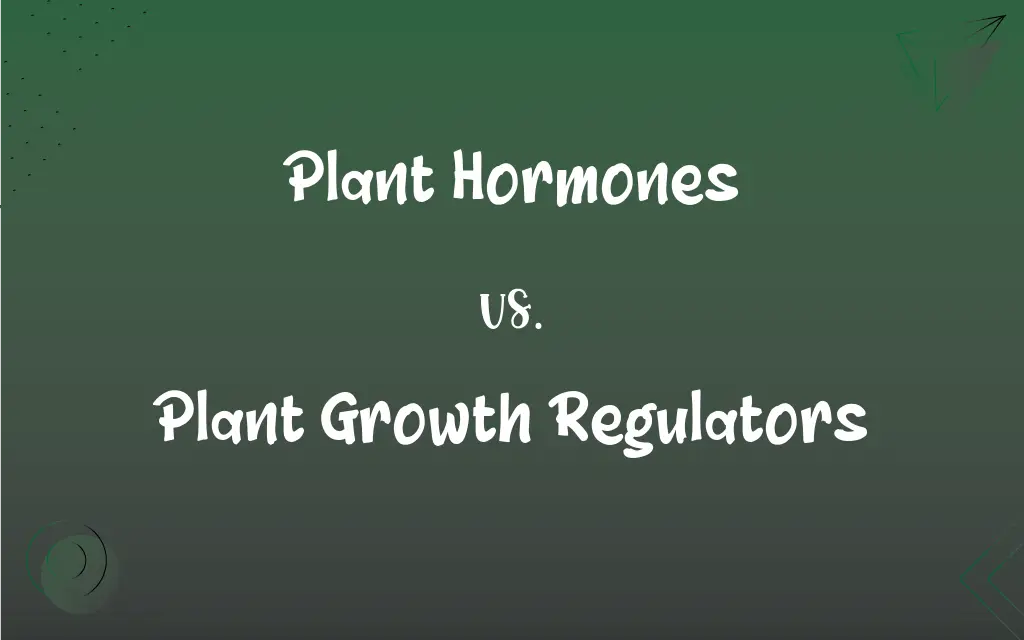Plant Hormones vs. Plant Growth Regulators: What's the Difference?
Edited by Aimie Carlson || By Janet White || Published on August 1, 2024
Plant hormones are naturally occurring substances that regulate plant growth, whereas plant growth regulators can be both natural and synthetic compounds used to influence plant growth.

Key Differences
Plant hormones, also known as phytohormones, are naturally produced within plants and play a crucial role in regulating their growth and development. In contrast, plant growth regulators encompass a broader category that includes both naturally occurring hormones and synthetic substances designed to modify plant growth processes. While plant hormones are endogenous, plant growth regulators can be applied externally to achieve desired effects.
The production of plant hormones occurs internally, and these compounds are essential for signaling within the plant, affecting cell division, elongation, and differentiation. Plant growth regulators, however, are often applied as agricultural or horticultural tools to manage plant growth, flowering, and fruiting, which includes both synthetic chemicals and natural hormones used for specific growth outcomes.
Plant hormones are involved in almost every aspect of plant life, including growth, flowering, fruit setting, senescence, and response to stress. Plant growth regulators, on the other hand, are used intentionally in agriculture and gardening to manipulate plant growth, such as speeding up flowering, enhancing fruit size, or controlling vegetative growth for more manageable plant sizes.
There are five main types of plant hormones: auxins, cytokinins, gibberellins, abscisic acid, and ethylene, each with specific roles in plant development. Plant growth regulators may mimic these hormones or inhibit their action, thus extending beyond natural hormones to include a range of synthetic compounds aimed at eliciting specific responses not necessarily confined to the plant's natural hormonal balance.
Understanding the mechanisms of plant hormones allows scientists and agriculturists to better grasp how plants grow and respond to their environment. The study and application of plant growth regulators, however, provide tools to modify these natural processes, offering ways to enhance crop yield, improve plant health, or control growth for commercial and aesthetic purposes.
ADVERTISEMENT
Comparison Chart
Origin
Produced naturally within plants.
Can be natural or synthetic.
Purpose
Regulate natural growth and development processes.
Manipulate growth for specific outcomes, including commercial.
Application
Internal, through the plant's own metabolic processes.
Applied externally, often for agricultural or horticultural use.
Types
Includes auxins, cytokinins, gibberellins, abscisic acid, ethylene.
Includes natural hormones and synthetic compounds.
Effects
Influences processes like cell division and differentiation.
Designed to modify or control specific growth aspects.
ADVERTISEMENT
Plant Hormones and Plant Growth Regulators Definitions
Plant Hormones
Plant hormones that promote stem elongation and root growth.
The application of auxin encouraged the cuttings to develop roots.
Plant Growth Regulators
Compounds used to stimulate root formation on cuttings.
The gardener applied rooting agents to the cuttings for better root development.
Plant Hormones
Hormones that stimulate cell division and shoot growth.
Cytokinins were applied to encourage the plant to produce more shoots.
Plant Growth Regulators
Chemicals used to delay the aging process in plants.
Senescence delayers helped keep the flowers fresh for a longer period.
Plant Hormones
A gaseous hormone involved in fruit ripening and leaf abscission.
The presence of ethylene accelerated the ripening of the tomatoes.
Plant Growth Regulators
Substances that slow down plant growth.
Growth inhibitors were used to maintain the compact size of the ornamental plants.
Plant Hormones
Hormones that promote stem elongation and seed germination.
Gibberellins broke the dormancy of the seeds, initiating germination.
Plant Growth Regulators
Chemicals that promote or induce flowering.
The application of flowering inducers ensured the plants bloomed at the desired time.
Plant Hormones
A hormone that regulates stress responses and seed dormancy.
Abscisic acid levels increased, causing the plant to enter a dormant state.
Plant Growth Regulators
Compounds that increase the rate of fruit set and development.
Fruit set enhancers were sprayed to improve the yield of the fruit trees.
FAQs
What is the main purpose of using plant growth regulators?
To manipulate plant growth for specific outcomes, such as enhanced yield or controlled size.
What are plant growth regulators?
Plant growth regulators can be natural or synthetic compounds used to influence plant growth.
How many types of plant hormones are there?
There are five main types: auxins, cytokinins, gibberellins, abscisic acid, and ethylene.
Do plant growth regulators affect all plants the same way?
No, the effect of plant growth regulators varies depending on the plant species and the compound used.
Can plant hormones be applied externally like plant growth regulators?
Typically, plant hormones act internally, but some synthetic versions can be applied externally.
How does ethylene affect plant processes?
Ethylene is involved in fruit ripening, leaf abscission, and response to stress.
How do plant hormones differ from plant growth regulators?
Plant hormones are produced internally, while plant growth regulators include external applications.
Are plant growth regulators safe for all plants?
Safety depends on the compound and its application; proper usage is crucial to avoid damage.
How do auxins influence plant development?
Auxins promote stem elongation, root growth, and differentiation.
What is the effect of gibberellins on plants?
Gibberellins are crucial for stem elongation, seed germination, and breaking dormancy.
What are plant hormones?
Plant hormones are naturally occurring substances that regulate plant growth and development.
Can plant growth regulators be natural?
Yes, some plant growth regulators are natural, mimicking the action of plant hormones.
What are the benefits of using plant growth regulators in agriculture?
They can enhance crop yield, improve quality, and control growth for better management.
How are plant growth regulators applied to plants?
They can be applied through foliar sprays, soil drenches, or other methods depending on the desired effect.
What role do cytokinins play in plant growth?
Cytokinins stimulate cell division and shoot growth in plants.
What research is being done on plant hormones and plant growth regulators?
Research focuses on understanding their mechanisms and developing new compounds for agriculture and horticulture.
Can plant growth regulators be used in organic farming?
Only natural plant growth regulators are typically allowed in organic farming.
Do all plants produce the same levels of hormones?
No, hormone levels vary among plant species, developmental stages, and environmental conditions.
Why is abscisic acid important for plants?
Abscisic acid regulates stress responses and seed dormancy, helping plants cope with adverse conditions.
Can excessive use of plant growth regulators be harmful?
Yes, misuse or overuse can lead to negative effects on plant health and development.
About Author
Written by
Janet WhiteJanet White has been an esteemed writer and blogger for Difference Wiki. Holding a Master's degree in Science and Medical Journalism from the prestigious Boston University, she has consistently demonstrated her expertise and passion for her field. When she's not immersed in her work, Janet relishes her time exercising, delving into a good book, and cherishing moments with friends and family.
Edited by
Aimie CarlsonAimie Carlson, holding a master's degree in English literature, is a fervent English language enthusiast. She lends her writing talents to Difference Wiki, a prominent website that specializes in comparisons, offering readers insightful analyses that both captivate and inform.






































































